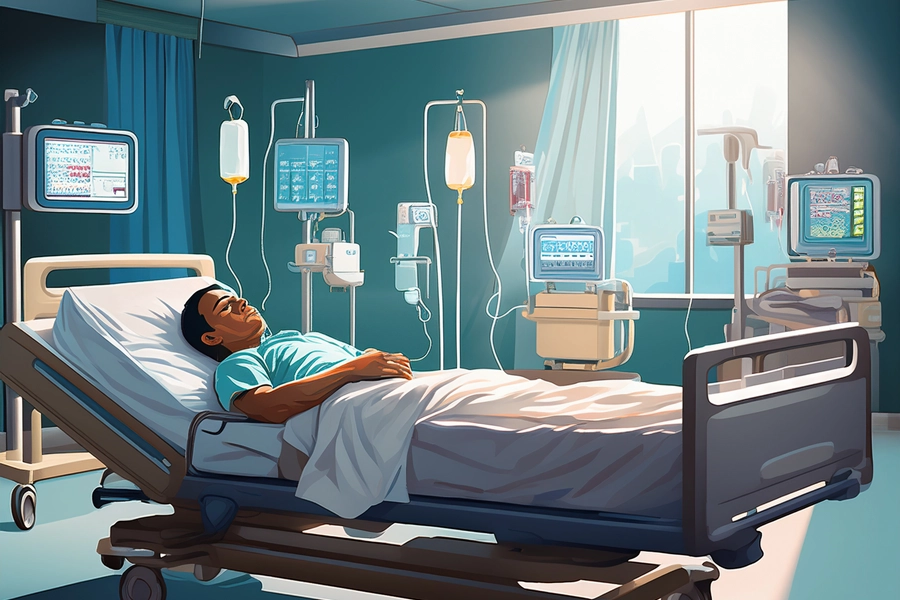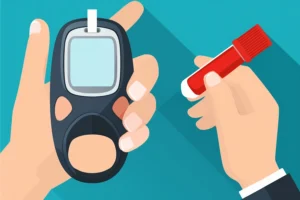Guillain-Barré Syndrome (GBS), a rare but serious neurological disorder that has recently gained global attention due to alarming developments related to outbreaks and vaccine-related concerns. Recently in Maharashtra, India, an outbreak of GBS has been linked to Campylobacter jejuni contamination, claiming twelve lives and affecting 225 individuals. Similarly, in Kerala, two deaths were reported in February,2025 further raising concerns about the spread of this debilitating condition. Alongside these outbreaks, the U.S. Food and Drug Administration (FDA) has issued warnings about a potential increased risk of GBS following the administration of RSV vaccines (It is a vaccine designed to protect against Respiratory Syncytial Virus, a common respiratory virus that can cause severe infections, particularly in infants, young children and older adults) developed by GSK and Pfizer. These developments underscore the growing importance of understanding and addressing the risks associated with GBS, especially in the context of infections and vaccination programs.
This article provides a comprehensive overview of Guillain-Barré Syndrome, covering its causes, symptoms and diagnostic approaches.
Introduction
Guillain-Barré Syndrome (GBS) is a rare but potentially life-threatening autoimmune disorder that primarily affects the peripheral nervous system, often following an infection.1 While it is more prevalent in adults, particularly males, individuals of all ages can be affected.2 GBS occurs when the body’s immune system mistakenly attacks the peripheral nerves, which are responsible for transmitting signals from the brain and spinal cord to the rest of the body. This immune response can disrupt the function of nerves that control muscle movement and those responsible for sensory functions such as pain, temperature and touch. As a result, individuals may experience symptoms such as muscle weakness, loss of sensation in the limbs and difficulties with swallowing or breathing.2
The onset of GBS is typically abrupt, with symptoms worsening over hours, days or weeks. In some cases, the condition remains mild, characterized by brief episodes of weakness. However, in more severe instances, GBS can progress to significant paralysis, potentially impairing the ability to breathe independently. When left untreated, GBS can become life-threatening, compromising critical physiological functions including respiration, heart rate and blood pressure.
Despite the severity of the condition, the majority of individuals recover, even from the most extreme manifestations of GBS, although some may experience residual weakness following recovery.3
GBS is known to have at least five distinct subtypes, each with unique characteristics and mechanisms. These subtypes are variations of acute peripheral neuropathy, where the nerves outside the brain and spinal cord are damaged.
The main subtypes of Guillain-Barré Syndrome are:
- Acute Inflammatory Demyelinating Polyradiculoneuropathy (AIDP):4
AIDP is the most common subtype of Guillain-Barré Syndrome (GBS). It occurs when the immune system attacks the myelin proteins (P0, P2, PMP22), crucial for peripheral nerve function, leading to nerve inflammation and damage. While T-cell-mediated immunity is involved, antibodies and complement proteins may also play a role, though the exact mechanisms are unclear. AIDP is often triggered by infections, particularly respiratory or gastrointestinal, though its exact cause is not fully understood. Symptoms include muscle weakness, numbness and potentially paralysis.
- Acute Motor Axonal Neuropathy (AMAN):4
AMAN is a subtype of Guillain-Barré Syndrome where the immune system attacks the axons, the long nerve fibers responsible for transmitting electrical impulses. Unlike other subtypes that affect myelin, AMAN causes axonal damage, disrupting nerve signaling and leading to motor weakness or paralysis. AMAN is more common in areas where Campylobacter jejuni, a bacteria linked to foodborne illness, is prevalent. This subtype can lead to more severe and long-term neurological impairments
- Acute Motor and Sensory Axonal Neuropathy (AMSAN):5
AMSAN is a rare and severe variant of Guillain-Barré Syndrome (GBS) characterized by axonal degeneration affecting both motor and sensory nerve fibers. In AMSAN, the immune system attacks the axons, which are responsible for transmitting both motor (movement-related) and sensory (touch, pain, temperature) signals. This dual impact leads to significant motor weakness, paralysis and sensory loss. AMSAN typically presents with more severe symptoms and a prolonged recovery compared to other GBS subtypes.
- Fisher’s Syndrome:(6,7)
Miller Fisher Syndrome (MFS) is a rare variant of Guillain-Barré Syndrome (GBS), typically presenting with at least two of the following features: ataxia (lack of coordination), areflexia (absence of reflexes) and ophthalmoplegia (weakness of eye muscles). Unlike other GBS subtypes, MFS commonly involves the lower cranial and facial nerves and typically does not cause significant motor weakness in the limbs
- Acute Panautonomic Neuropathy:
Acute Panautonomic Neuropathy is the rarest variant of Guillain-Barré Syndrome (GBS), characterized by widespread involvement of both the sympathetic and parasympathetic nervous systems. This condition commonly affects the cardiovascular system, leading to complications such as postural hypotension, tachycardia, hypertension and cardiac arrhythmias. Additionally, individuals may experience blurry vision, dry eyes and anhidrosis (absence of sweating) due to autonomic dysfunction. Sensory abnormalities may also be present in some cases. Recovery from acute panautonomic neuropathy tends to be slow and often incomplete, making long-term management essential for affected individuals.8
Causes Of Guillain-Barré Syndrome
Guillain-Barré Syndrome (GBS) is a rare neurological disorder, and its exact cause remains uncertain.
1. Infections:2 GBS is typically triggered by a preceding viral or bacterial infection.
a. Bacterial infections: Campylobacter jejuni, which causes gastroenteritis, is one of the most common bacterial triggers for GBS.
b. Viral infections: Infections such as flu (influenza), cytomegalovirus (CMV), Epstein-Barr virus (EBV), HIV and Zika virus have been linked to GBS.
a. RSV Vaccines (Abrysvo & Arexvy): The FDA released a safety communication warning about a potential risk of Guillain-Barré Syndrome (GBS) associated with RSV vaccines developed by Pfizer (Abrysvo) and GSK (Arexvy).9
b. COVID-19 Vaccines: Some reports suggest a possible association between COVID-19 vaccines (such as Oxford–AstraZeneca , Pfizer-BioNTech, Moderna, and Johnson and Johnson) and GBS, though cases are rare.10,11
c. Influenza (Flu) Vaccine: The 1976 swine flu vaccine was linked to an increased incidence of GBS.12 However, subsequent flu vaccines have shown only a minimal risk, with studies suggesting that the flu itself poses a greater risk for GBS than the vaccine.
d. Other Vaccines: Vaccination has been identified as a potential trigger for Guillain-Barré Syndrome, with cases reported following various vaccines, including those for rabies, diphtheria-pertussis-tetanus (DPT), rubella, tetanus toxoid, hepatitis A and B, and influenza. Symptoms typically appear within two weeks after vaccination. However, for most of these vaccines, a direct causal link to GBS has not been conclusively established.10
Symptoms of Guillain- Barré Syndrome
1. Initial Symptoms: 13
- Acroparesthesia (abnormal tingling or burning sensations) with minimal sensory loss
- Severe radicular back pain or neuropathic pain
- Ascending weakness (starts in the legs, spreads to the arms) – most common pattern
- Descending weakness (starts in the face or arms, mimicking botulism) – less common
- Weakness may be asymmetric in rare cases
- Facial nerve involvement, leading to facial weakness
- Respiratory muscle weakness, potentially causing breathing difficulty and respiratory failure
- Hypo- or areflexia (reduced or absent reflexes) within the first few days
- Variable sensory loss, rarely presenting as a pseudo-sensory level suggesting myelopathy
- Dysphagia (difficulty swallowing)
- Ophthalmoplegia (eye muscle paralysis), causing diplopia (double vision).
- ptosis (drooping eyelids)
- Less common: Hearing loss, papilledema and vocal cord paralysis
- Cardiovascular symptoms: Sinus tachycardia (most common), bradycardia, cardiac arrhythmias
- Blood pressure abnormalities: Hypertension, hypotension, orthostatic hypotension
- Sweating irregularities
- Gastrointestinal and bladder dysfunction:
a. Urinary retention (inability to urinate)
b. Gastrointestinal issues: Constipation, ileus, diarrhea, fecal incontinence, gastric distension
- Neuropathic or radicular pain, common across all GBS subtypes, including Miller Fisher Syndrome (MFS)
- Persistent pain often occurs before weakness onset
- Pain is common in the acute phase and some patients experience lingering pain for up to a year.
- Weakness peaks within two weeks in 50% of cases and within four weeks in 90%
- Progression beyond one month may indicate subacute inflammatory demyelinating polyradiculoneuropathy.
- Weakness persisting for more than eight weeks suggests chronic inflammatory demyelinating polyradiculoneuropathy (CIDP).
- Some cases deteriorate rapidly, leading to respiratory failure within hours or days, while others progress more slowly without significant loss of mobility
- A small percentage of cases mimic a spinal cord lesion, presenting with bladder and gastrointestinal dysfunction
Diagnosis
Distinguishing Guillain-Barré Syndrome (GBS) from other conditions can be challenging because many disorders present with similar symptoms, especially in the early stages. Because GBS often begins with symptoms like muscle weakness, sensory loss and autonomic dysfunction, it can resemble various other neurological and systemic disorders. Therefore, a careful evaluation is required to ensure an accurate diagnosis. Clinicians typically rely on the following methods to diagnose GBS:
1. Complete Blood Count (CBC): Helps to assess overall health and detect infections or blood-related issues.15
3. Cerebrospinal Fluid (CSF) Analysis:
a. Elevated protein level: Greater than 0.55 g/dL without pleocytosis (normal cell count), a hallmark of GBS, typically appears after 48-72 hours of symptom onset.8
b. CSF white blood cell count: A small increase in WBC (10-100 cells/mm³) can indicate conditions like Lyme disease, HIV or neoplasia, which need to be ruled out.8
4. Electrodiagnostic Studies (Nerve Conduction Studies):
Absent H reflex, low amplitude or absent sensory nerve action potentials and abnormal F waves are suggestive of GBS.8
5. Serum Anti-Ganglioside Antibody Testing:
Testing for anti-ganglioside antibodies, though limited in diagnostic value, can be useful in uncertain cases. Anti-GQ1b antibodies, these are particularly important in diagnosing Miller Fisher Syndrome (MFS), as they are found in up to 90% of MFS patients.15
6. Testing for Preceding Infections:
While not routinely used for diagnosing GBS, identifying recent infections (e.g., Campylobacter jejuni or Zika virus) can help to determine the cause, especially during outbreaks.15 These tests help to exclude other potential causes and confirm the diagnosis of GBS, although diagnosis is primarily based on clinical presentation and electrodiagnostic findings.
These tests help to exclude other potential causes and confirm the diagnosis of GBS, although diagnosis is primarily based on clinical presentation and electrodiagnostic findings.
Conclusion
Guillain-Barré Syndrome (GBS) is a rare but potentially life-threatening disorder that affects the peripheral nervous system, often triggered by infections or, in some cases, vaccines. Despite its severity, with the potential to cause rapid paralysis and respiratory failure, most individuals recover, although some may experience residual weakness. Understanding the causes, symptoms and subtypes of GBS is crucial for early identification and intervention.
The diagnosis of GBS requires careful consideration of clinical features, such as muscle weakness, sensory abnormalities and autonomic dysfunction, alongside diagnostic tests like cerebrospinal fluid analysis, electrodiagnostic studies and in some cases, anti-ganglioside antibody testing. Although the condition can be mistaken for other disorders, distinguishing GBS from other diseases is possible with a thorough clinical evaluation and appropriate testing.
Given the global concern about outbreaks and the potential risks associated with vaccines, it is essential for healthcare professionals and the public to remain vigilant and informed. Early diagnosis and timely treatment are key to improving outcomes for individuals affected by GBS. This highlights the need for increased awareness, swift intervention and ongoing research into the condition and its underlying causes.
References
- Nguyen TP, Taylor RS. Guillain-Barre Syndrome. [Updated 2023 Feb 7]. In: StatPearls [Internet]. Treasure Island (FL): StatPearls Publishing; 2025 Jan. Accessed on March 9,2025. Available from: https://www.ncbi.nlm.nih.gov/books/NBK532254/
- Guillain–Barré syndrome. Worl Health Organization. Published on August 15, 2023. Accessed on March 9, 2025. Available from: https://www.who.int/news-room/fact-sheets/detail/guillain-barr%C3%A9-syndrome
- National Institute of Neurological disorders and Stroke. Guillain-Barré Syndrome. NIH. Last reviewed on January 31, 2025. Accessed on March 9, 2025. Available from: https://www.ninds.nih.gov/health-information/disorders/guillain-barre-syndrome
- Hughes, Richard AC et al. Guillain-Barré syndrome. The Lancet.2005;366(9497):1653 – 1666. https://www.thelancet.com/journals/laneur/article/PIIS0140-6736(05)67665-9/abstract
- Liu DY, Hollenbach JR, Gregorin JA, Wynbrandt JH. A Case of Acute Motor Sensory Axonal Neuropathy: A Variant of Guillain-Barré Syndrome, with Possible Syndrome of Irreversible Lithium-Effectuated Neurotoxicity. Case Rep Med. 2020 Apr 20;2020:4683507. https://pmc.ncbi.nlm.nih.gov/articles/PMC7189311/#sec3
- Snyder LA, Rismondo V, Miller NR. The Fisher variant of Guillain-Barré syndrome (Fisher syndrome). J Neuroophthalmol. 2009 Dec;29(4):312-24. https://pubmed.ncbi.nlm.nih.gov/19952907/#:~:text=Fisher%20syndrome%20(FS)%20is%20an,1%20of%20these%20clinical%20findings.
- Rocha Cabrero F, Morrison EH. Miller Fisher Syndrome. [Updated 2023 Jun 26]. In: StatPearls [Internet]. Treasure Island (FL): StatPearls Publishing; 2025 Jan-. Accessed on March 9,2025. Available from: https://www.ncbi.nlm.nih.gov/books/NBK507717/
- DANA L. NEWSWANGER, CHARLES R. WARREN. Guillain-Barré Syndrome. American Family Physician Web site. 2004;69:10. https://www.aafp.org/pubs/afp/issues/2004/0515/p2405.pdf
- Judy George. FDA adds Guillain Barre Syndrome Warning to To RSV vaccines. MEDPAGETODAY. Published on January 8, 2025. Accessed on March 10, 2025. Available from: https://www.medpagetoday.com/infectiousdisease/vaccines/113686
- Miao Yu, Shuang Nie, Yue Qiao, Ying Ma. Guillain-Barre syndrome following COVID-19 vaccines: A review of literature;REVIEW article. Frontiers in Immunology. 2023;14. https://www.frontiersin.org/journals/immunology/articles/10.3389/fimmu.2023.1078197/full
- Meo, S.A., Shaikh, N., Abukhalaf, F.A. et al.Exploring the adverse events of Oxford–AstraZeneca, Pfizer-BioNTech, Moderna, and Johnson and Johnson COVID-19 vaccination on Guillain–Barré Syndrome. Sci Rep 14, 18767 (2024). https://www.nature.com/articles/s41598-024-66999-7#Sec2
- Sophie Wei. Investigating Guillain-Barre Syndrome and Vaccines: Is There a Link?. Neuromuscular Disorders: NeurologyAdvisor. Published on July 28, 2023. Accessed on March10,2025. Available from: https://www.neurologyadvisor.com/features/investigating-guillain-barre-syndrome-and-vaccines-is-there-a-link/
- Zhang Yiliu , Huang Chuxin , Lu Wei , Hu Qing. Case Report: Delayed Guillain-Barré syndrome following trauma: A case series and manage considerations. Frontiers in Surgery. 2022;9. https://www.frontiersin.org/journals/surgery/articles/10.3389/fsurg.2022.903334/full
- Dimachkie MM, Barohn RJ. Guillain-Barré syndrome and variants. Neurol Clin. 2013 May;31(2):491-510. https://pmc.ncbi.nlm.nih.gov/articles/PMC3939842/
- Leonhard, S.E., Mandarakas, M.R., Gondim, F.A.A. et al.Diagnosis and management of Guillain–Barré syndrome in ten steps. Nat Rev Neurol. 2019;15, 671–683. https://www.nature.com/articles/s41582-019-0250-9#Sec10




